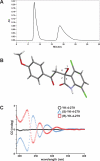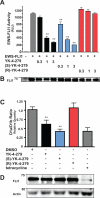Single enantiomer of YK-4-279 demonstrates specificity in targeting the oncogene EWS-FLI1
- PMID: 22383402
- PMCID: PMC3326647
- DOI: 10.18632/oncotarget.454
Single enantiomer of YK-4-279 demonstrates specificity in targeting the oncogene EWS-FLI1
Abstract
Oncogenic fusion proteins, such as EWS-FLI1, are excellent therapeutic targets as they are only located within the tumor. However, there are currently no agents targeted toward transcription factors, which are often considered to be 'undruggable.' A considerable body of evidence is accruing that refutes this claim based upon the intrinsic disorder of transcription factors. Our previous studies show that RNA Helicase A (RHA) enhances the oncogenesis of EWS-FLI1, a putative intrinsically disordered protein. Interruption of this protein-protein complex by small molecule inhibitors validates this interaction as a unique therapeutic target. Single enantiomer activity from a chiral compound has been recognized as strong evidence for specificity in a small molecule-protein interaction. Our compound, YK-4-279, has a chiral center and can be separated into two enantiomers by chiral HPLC. We show that there is a significant difference in activity between the two enantiomers. (S)-YK-4-279 is able to disrupt binding between EWS-FLI1 and RHA in an immunoprecipitation assay and blocks the transcriptional activity of EWS-FLI1, while (R)-YK-4-279 cannot. Enantiospecific effects are also established in cytotoxicity assays and caspase assays, where up to a log-fold difference is seen between (S)-YK-4-279 and the racemic YK-4-279. Our findings indicate that only one enantiomer of our small molecule is able to specifically target a protein-protein interaction. This work is significant for its identification of a single enantiomer effect upon a protein interaction suggesting that small molecule targeting of intrinsically disordered proteins can be specific. Furthermore, proving YK-4-279 has only one functional enantiomer will be helpful in moving this compound towards clinical trials.
Figures




Similar articles
-
Pharmacokinetic modeling optimizes inhibition of the 'undruggable' EWS-FLI1 transcription factor in Ewing Sarcoma.Oncotarget. 2014 Jan 30;5(2):338-50. doi: 10.18632/oncotarget.1495. Oncotarget. 2014. PMID: 24481407 Free PMC article.
-
Inhibition of the oncogenic fusion protein EWS-FLI1 causes G2-M cell cycle arrest and enhanced vincristine sensitivity in Ewing's sarcoma.Sci Signal. 2017 Oct 3;10(499):eaam8429. doi: 10.1126/scisignal.aam8429. Sci Signal. 2017. PMID: 28974650 Free PMC article.
-
YK-4-279 effectively antagonizes EWS-FLI1 induced leukemia in a transgenic mouse model.Oncotarget. 2015 Nov 10;6(35):37678-94. doi: 10.18632/oncotarget.5520. Oncotarget. 2015. PMID: 26462019 Free PMC article.
-
Therapeutic opportunities in Ewing sarcoma: EWS-FLI inhibition via LSD1 targeting.Oncotarget. 2016 Apr 5;7(14):17616-30. doi: 10.18632/oncotarget.7124. Oncotarget. 2016. PMID: 26848860 Free PMC article. Review.
-
Blocking the road, stopping the engine or killing the driver? Advances in targeting EWS/FLI-1 fusion in Ewing sarcoma as novel therapy.Expert Opin Ther Targets. 2014 Nov;18(11):1315-28. doi: 10.1517/14728222.2014.947963. Epub 2014 Aug 27. Expert Opin Ther Targets. 2014. PMID: 25162919 Review.
Cited by
-
Establishment and characterization of a novel patient-derived Ewing sarcoma cell line, NCC-ES2-C1.Hum Cell. 2022 Jul;35(4):1262-1269. doi: 10.1007/s13577-022-00701-9. Epub 2022 Apr 19. Hum Cell. 2022. PMID: 35441357
-
Targeted Therapy for EWS-FLI1 in Ewing Sarcoma.Cancers (Basel). 2023 Aug 9;15(16):4035. doi: 10.3390/cancers15164035. Cancers (Basel). 2023. PMID: 37627063 Free PMC article. Review.
-
The small molecule inhibitor YK-4-279 disrupts mitotic progression of neuroblastoma cells, overcomes drug resistance and synergizes with inhibitors of mitosis.Cancer Lett. 2017 Sep 10;403:74-85. doi: 10.1016/j.canlet.2017.05.027. Epub 2017 Jun 7. Cancer Lett. 2017. PMID: 28602975 Free PMC article.
-
An inhibitor of endothelial ETS transcription factors promotes physiologic and therapeutic vessel regression.Proc Natl Acad Sci U S A. 2020 Oct 20;117(42):26494-26502. doi: 10.1073/pnas.2015980117. Epub 2020 Oct 5. Proc Natl Acad Sci U S A. 2020. PMID: 33020273 Free PMC article.
-
Current Approaches for Personalized Therapy of Soft Tissue Sarcomas.Sarcoma. 2020 Mar 31;2020:6716742. doi: 10.1155/2020/6716742. eCollection 2020. Sarcoma. 2020. PMID: 32317857 Free PMC article. Review.
References
-
- Kim J, Pelletier J. Molecular genetics of chromosome translocations involving EWS and related family members. Physiol Genomics. 1999;1:127–138. - PubMed
-
- Delattre O, Zucman J, Plougastel B, Desmaze C, Melot T, Peter M, Kovar H, Joubert I, de Jong P, Rouleau G, et al. Gene fusion with an ETS DNA-binding domain caused by chromosome translocation in human tumours. Nature. 1992;359:162–165. - PubMed
-
- Darnell JE., Jr Transcription factors as targets for cancer therapy. Nature reviews Cancer. 2002;2:740–749. - PubMed
-
- Wright PE, Dyson HJ. Intrinsically unstructured proteins: re-assessing the protein structure-function paradigm. Journal of molecular biology. 1999;293:321–331. - PubMed
Publication types
MeSH terms
Substances
Grants and funding
LinkOut - more resources
Full Text Sources
Other Literature Sources

